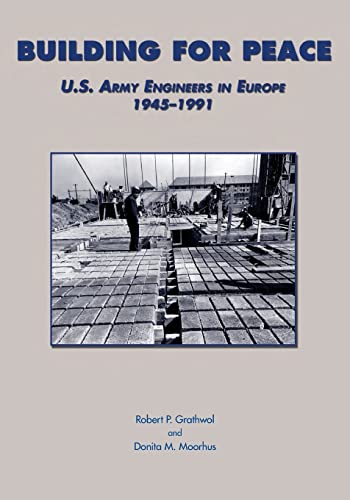Articles liés à Building for Peace: U.S. Army Engineers in Europe 1945-1991

Synopsis
Building for Peace traces the U.S. Army's engineering construction activities in Europe, beginning immediately after World War II in 1945 and ending with the dissolution of the Soviet Union in 1991. In their fine organizational account that details the twists and turns of the Cold War's history, Robert P. Grathwol and Donita M. Moorhus describe the often less glamorous but nonetheless critical missions of conscientious Army engineers-military officers, civilians, and local-national employees and contractors-who worked tirelessly to prepare the physical infrastructure in Europe, the battleground of what was perceived as the next Armageddon. The U.S. Army Corps of Engineers played a central role in building and maintaining the infrastructure in support of the U.S. and NATO forces that stood on the front lines of the Cold War. Grathwol's and Moorhus's study, covering almost a half-century of military construction in Europe that cost more than $5 billion, serves to record not only the achievements of Army engineers but also their contribution to the legacy of the peaceful triumph of democracy. This story is worth reading and remembering.
Les informations fournies dans la section « Synopsis » peuvent faire référence à une autre édition de ce titre.
Présentation de l'éditeur
Building for Peace traces the U.S. Army's engineering construction activities in Europe, beginning immediately after World War II in 1945 and ending with the dissolution of the Soviet Union in 1991. In their fine organizational account that details the twists and turns of the Cold War's history, Robert P. Grathwol and Donita M. Moorhus describe the often less glamorous but nonetheless critical missions of conscientious Army engineers-military officers, civilians, and local-national employees and contractors-who worked tirelessly to prepare the physical infrastructure in Europe, the battleground of what was perceived as the next Armageddon. The U.S. Army Corps of Engineers played a central role in building and maintaining the infrastructure in support of the U.S. and NATO forces that stood on the front lines of the Cold War. Grathwol's and Moorhus's study, covering almost a half-century of military construction in Europe that cost more than $5 billion, serves to record not only the achievements of Army engineers but also their contribution to the legacy of the peaceful triumph of democracy. This story is worth reading and remembering.
Les informations fournies dans la section « A propos du livre » peuvent faire référence à une autre édition de ce titre.
Gratuit expédition vers Etats-Unis
Destinations, frais et délaisAcheter neuf
Afficher cet articleEUR 22,36 expédition depuis Royaume-Uni vers Etats-Unis
Destinations, frais et délaisRésultats de recherche pour Building for Peace: U.S. Army Engineers in Europe 1945-1991
Building for Peace: U.S. Army Engineers in Europe 1945-1991
Vendeur : ThriftBooks-Atlanta, AUSTELL, GA, Etats-Unis
Paperback. Etat : Fair. No Jacket. Readable copy. Pages may have considerable notes/highlighting. ~ ThriftBooks: Read More, Spend Less 1.91. N° de réf. du vendeur G1505572916I5N00
Quantité disponible : 1 disponible(s)
Building for Peace: U.S. Army Engineers in Europe 1945-1991
Vendeur : Under Charlie's Covers, Bernalillo, NM, Etats-Unis
Soft cover. Etat : Very Good. Very good soft cover with minor water damage on the bottom corner. N° de réf. du vendeur 002043
Quantité disponible : 1 disponible(s)
Building for Peace: U.S. Army Engineers in Europe 1945-1991
Vendeur : THE SAINT BOOKSTORE, Southport, Royaume-Uni
Paperback / softback. Etat : New. This item is printed on demand. New copy - Usually dispatched within 5-9 working days. N° de réf. du vendeur C9781505572919
Quantité disponible : Plus de 20 disponibles
Building for Peace (Paperback)
Vendeur : CitiRetail, Stevenage, Royaume-Uni
Paperback. Etat : new. Paperback. Building for Peace traces the U.S. Army's engineering construction activities in Europe, beginning immediately after World War II in 1945 and ending with the dissolution of the Soviet Union in 1991. In their fine organizational account that details the twists and turns of the Cold War's history, Robert P. Grathwol and Donita M. Moorhus describe the often less glamorous but nonetheless critical missions of conscientious Army engineers-military officers, civilians, and local-national employees and contractors-who worked tirelessly to prepare the physical infrastructure in Europe, the battleground of what was perceived as the next Armageddon. The U.S. Army Corps of Engineers played a central role in building and maintaining the infrastructure in support of the U.S. and NATO forces that stood on the front lines of the Cold War. Grathwol's and Moorhus's study, covering almost a half-century of military construction in Europe that cost more than $5 billion, serves to record not only the achievements of Army engineers but also their contribution to the legacy of the peaceful triumph of democracy. This story is worth reading and remembering. Shipping may be from our UK warehouse or from our Australian or US warehouses, depending on stock availability. N° de réf. du vendeur 9781505572919
Quantité disponible : 1 disponible(s)

